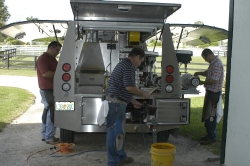Many times I have been asked, “Did you put the speed shoes on?”
This is said in jest. I often jokingly reply, “No, but I put them on fast.”
The question is, how long should it take to shoe a horse? Most farriers schedule one hour; however many things influence the time required to do the job. Bar shoes, pads, and borium are just a few examples of these time consuming add-ons.
Sometimes farriers work as a two-person team in order to shorten the duration. One works the floor (horse); this is normally the farrier in charge of the shop. The other works the fire (shoe making). Both people do their part with the idea of doing as much work simultaneously as possible. (By the way, please don’t ask the farrier’s assistant to hold the horse as he is there to help with other task.)
When two farriers have worked together for a long time they become quite synchronized and efficient. Many years ago it was the norm to see two people in the shop because it was a much more labor-intensive job then. The vast improvement of pre-manufactured shoes has taken out much of the forge work necessary to produce a well-fitted shoe.
A drawback to that is that it has also taken away the need for those skills which produced a good shoe in those days. Often farriers would work into the night producing shoes for the next day. Those craftsmen worked very hard and in doing so developed amazing forging skills still evident today on the shoe rack in the Harness Racing Hall of Fame in Goshen, N.Y., as I have noted in a previous article. When I started helping my dad in the early ‘70s, only a few farriers still forged all their shoes from straight bars.
 Members of a farrier team often split up duties to streamline the workflow, which allows them to address the shoeing needs of as many horses as possible in a single visit.
Members of a farrier team often split up duties to streamline the workflow, which allows them to address the shoeing needs of as many horses as possible in a single visit.
In the Thoroughbred industry, the speed of a shoeing job is equated to competency. I was told by a good farrier in that industry that if you are not done in 20 minutes they perceive you as incompetent. I have many times spent that long looking at the horse and talking to the trainer before work even begins. In any workplace, perception of your employer is everything to your employment. On those Thoroughbred tracks I’m told “if you don’t get done in 20-30 minutes, someone else will.” I find that somewhat ironic since every year it seems we read about a high-profile Kentucky Derby contender being knocked out by a hoof problem.
Many believe that hoof problems in Thoroughbred racehorses are inherent. If there is any truth to that statement then I question why those farriers are pressed to get done so fast? Standardbreds also have their share of hoof problems, but I do think they are less prevalent.
When shoeing for speed small things can be omitted. Possibly checking a questionable hoof with testers, beveling a shoe more with a grinder, or even dressing the hoof before fitting the shoe are a few examples. These things are not essential to getting the horse shod, but could impact the effectiveness of a shoeing job.
There are definitely days where a farrier gets into a groove. On these days, shoes come out of the fire, onto the anvil, and match the hoof perfectly without a re-fit. Horses get done in 30-40 minutes without a helper. You actually regret being done with the day because they don’t happen like this all the time. Distractions of the mind are usually the reason. Thinking about how to get 18 horses shod in one day is distracting; doing half that many is a hard day.
Watching a two-man team working efficiently together and getting horses done in 30 minutes is a marvel to see. Watching people working at a breakneck pace to try and shoe more horses in a day is not. I don’t think that exists much at harness tracks, though. For one, the shoes themselves and manipulation of them requires more work. Also, unique to harness racing are certain types interference and, of course, maintaining gait. These two considerations alone can add time to the shoeing job and, coincidentally, take time off of the race!
Sometimes going to the blacksmith shop is considered as time out of the day; however, if a stable considers that time talking with the farrier and staying with the horse as an investment, I believe it can reap huge rewards.
Veteran Standardbred farrier Steve Stanley of Lexington, Ky., authors a monthly column for Hoof Beats, the official harness racing publication of the U.S. Trotting Association. The American Farriers Journal Editorial Advisory Board member offers plenty of practical advice that will be of special interest regardless of the type of horses that you work with. Click here to read more from Steve Stanley's Hoof Beats series.








Post a comment
Report Abusive Comment